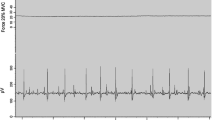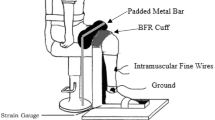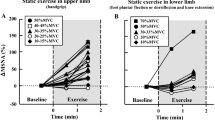Summary
To determine whether or not muscle endurance training alters exercise-induced sympathetic nerve response, we recorded muscle sympathetic nerve activity (MSNA) microneurographically during forearm exercise and compared MSNA between dominant (D) and nondominant (ND) forearms of players of racket sports. Three kinds of forearm exercise were conducted on each side; static (SHG) and dynamic (DHG, at a rate of 1 Hz) handgrip exercise at a loading of 25°10 of maximal voluntary contraction until exhaustion, and 10-min submaximal dynamic handgrip (at a rate of 1 Hz) at an intensity of 0.9 W. Heart rate, ventilation and blood pressure were also monitored at rest and during SHG and DHG exercises. During the last minute of SHG exercise, MSNA burst rate had increased on average by 290 (SEM 46) % in D and 330 (SEM 46) % in ND, while during DHG it increased by 288 (SEM 38) % in D and 344 (SEM 36) % in ND, respectively. There were no significant differences in the MSNA responses between D and ND forearms in either exercise modes. Significant increases in heart rate, ventilation and blood pressure during the last minute of fatiguing SHG and DHG were observed, but there were no significant differences between the two forearms. During submaximal DHG, while MSNA increased significantly above control values in both D and ND, the MSNA response was less in D than that in ND forearm. The results would suggest that exercise-induced MSNA responsiveness is influenced little by muscle endurance training but the intensity of response may be due to the magnitude of metaboreceptor stimulation in the exercising muscle.
Similar content being viewed by others
References
Andersen P, Henriksson J (1977) Capillary supply of the quandriceps femoris muscle of man: adaptive response to exercise. J Physiol 270:677–690
Åstrand P-O, Rodahl K (1970) Textbook of work physiology. McGraw-Hill, New York, pp 375–430
Christensen NJ, Galbo H (1983) Sympathetic nervous activity during exercise. Annu Rev Physiol 45:139–153
Clausen JP, Klausen K, Rasmussen B, Trap-Jensen J (1973) Central and peripheral circulatory changes after training of the arms or legs. Am J Physiol 225:675–682
Constable SH, Favier RJ, McLane JA, Fell RD, Chen M, Holloszy Jo (1987) Energy metabolism in contracting rat skeletal muscle: adaptation to exercise training. Am J Physiol 253:C316-C322
Eckberg DL, Nerhed C, Wallin BG (1985) Respiratory modulation of muscle sympathetic and vagal cardiac outflow in man. J Physiol (Lond) 365:181–196
Esler M, Jennings G, Leonard P, Sacharias N, Burke F, Johnes J, Blomberg P (1984) Contribution of individual organs to total noradrenaline release in humans. Acta Physiol Scand [Suppl] 527:11–16
Holloszy JO, Coyle EF (1984) Adaptation of skeletal muscle to endurance exercise and their metabolic consequences. J Appl Physiol Respir Environ Exerc Physiol 56:831–838
Jönig W (1985) Organization of the lumber sympathetic outflow to skeletal muscle and skin of the cat hindlimb and tail. Rev Physiol Biochem Pharmacol 102:119–213
Mark AL, Victor RG, Nerhed C, Wallin BG (1985) Microneurographic studies of the mechanisms of sympathetic nerve responses to static exercise in humans. Circ Res 57:461–469
Minotti JR, Johanson EC, Hudson TL, Sibbit RR, Wise LE, Fukushima E, Icenogle MV (1989) Forearm metabolic asymmetry detected by 31P-NMR during submaximal exercise. J Appl Physiol 67:324–329
Rea RF, Eckberg DL, Fritsch JM, Goldstein DS (1990) Relation of plasma norepinephrine and sympathetic traffic during hypotension in humans. Am J Physiol 258: R982-R986
Saito M, Mano T, Abe H, Iwase S (1986) Response in muscle sympathetic nerve activity to sustained hand-grips of different tension in humans. Eur J Appl Physiol 55:493–498
Saito M, Abe H, Iwase S, Mano T (1989a) Responses in muscle sympathetic nerve activity in human to sustained and rhythmic muscle contractions. Environ Med 33:33–41
Saito M, Mano T, Iwase S (1989b) Sympathetic nerve activity related to local fatigue sensation during static contraction. J Appl Physiol 67:980–984
Sale D (1987) Influence of exercise and training on motor unit activation. Exerc Sport Sci Rev 15:95–151
Saltin B, Nazar K, Costill DL, Stein E, Jansson E, Essen B, Gollnick PD (1976) The nature of the training response; peripheral and central adaptation to one-legged exercise. Acta Physiol Scand 96:289–305
Seals DR (1991) Sympathetic neutral adjustments to stress in physically trained and untrained humans. Hypertension 17:36–43
Sinoway LI, Musch TI, Minotti JR, Zelis R (1986) Enhanced maximal metabolic vasodilation in the dominant forearm of tennis players. J Appl Physiol 61:673–678
Sinoway LI, Shenberger J, Wilson J, McLaughlin D, Musch T, Zelis R (1987) A 30-day forearm work protocol increases maximal forearm blood flow. J Appl Physiol 62:1063–1067
Sinoway L, Rea R, Mark A (1989) The training effect of arm dominance attenuates sympathetic responses to muscle metaboreceptor stimulation (abstract). Clin Res 37:592A
Snell PG, Martin WH, Buckey JC, Blomqvist CG (1987) Maximal vascular leg conductance in trained and untrained men. J Appl Physiol 62:606–610
Somers VK, Leo KC, Green MP, Mark AL (1988) Forearm training alters the sympathetic nerve response to isometric handgrip (abstract). Circulation 78 [Suppl II]: II-177
Sundlöf G, Wallin BG (1977) The varaibility of muscle nerve sympathetic activity in resting recumbent man. J Physiol 272: 383–397
Svedenhag J, Wallin BG, Sundlöf G, Henriksson J (1984) Skeletal muscle sympathetic activity at rest in trained and untrained subjects. Acta Physiol Scand 120:499–504
Vallbo ÅB, Hagbarth K-H, Torebjök HE, Wallin BG (1979) Somatosensory, proprioceptive, and sympathetic activity in human peripheral nerves. Physiol Rev 59:919–957
Victor RG, Seals DR (1989) Reflex stimulation of sympathetic out flow during rhythmic exercise in humans. Am J Physiol 257: H2017-H2024
Victor PV, Bertocci LA, Pryor SL, Nunnally RL (1988) Sympathetic nerve discharge is coupled to muscle cell pH during exercise in humans. J Clin Invest 82:1301–1305
Victor PV, Pryor SL, Secher NH, Mitchell JH (1989) Effects of partial neuromuscular blockade on sympathetic nerve responses to static exercise in humans. Circ Res 65:468–476
Vodak PV, Savin WM, Haskell WL, Wood PD (1980) Physiological-profile of middle-aged male and female tennis players. Med Sci Sports Exerc 12:159–163
Wallin BG, Sundlöf G, Eriksson BM, Dominiak P, Grobecker H, Lindblad L-E (1981) Plasma noradrenaline correlates to sympathetic muscle nerve activity in normotensive man. Acta Physiol Scand 111:69–73
Winder WW, Hagberg JM, Hickson RC, Ehsani AA, McLane JA (1978) Time course of sympathoadrenal adaptation to endurance exercise training in man. J Appl Physiol Respir Environ Exerc Physiol 45:370–374
Author information
Authors and Affiliations
Rights and permissions
About this article
Cite this article
Saito, M., Watanabe, H. & Mano, T. Comparison of muscle sympathetic nerve activity during exercise in dominant and nondominant forearm. Europ. J. Appl. Physiol. 66, 108–115 (1993). https://doi.org/10.1007/BF01427050
Accepted:
Issue Date:
DOI: https://doi.org/10.1007/BF01427050




